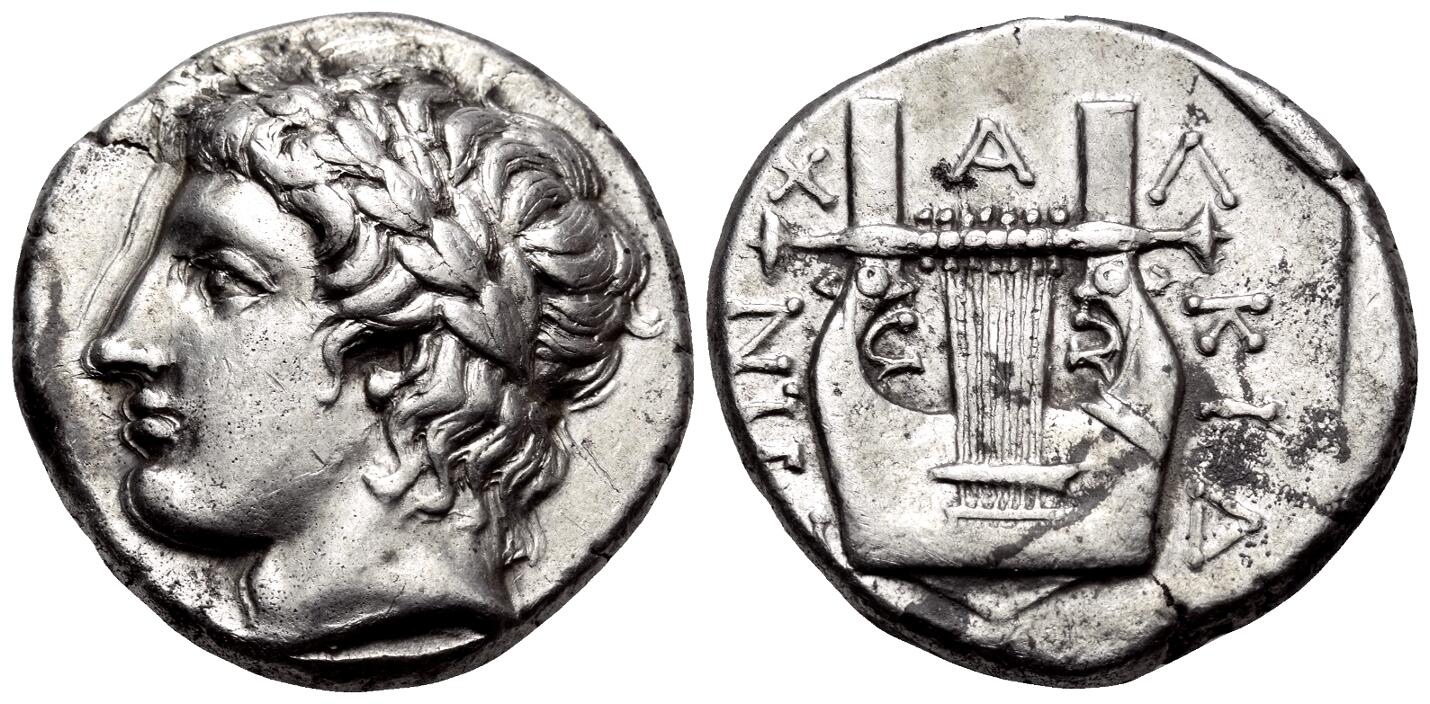AC 156 - Olynthus (Chalcidian League), silver, tetradrachms (420-348 BCE)
From SILVER
420 BCE - 348 BCE Silver 29,172 kg
Description
| ObverseInscription or printing placed on the obverse.: | Laureate head of Apollo to left, some strands of hair falling down the back of his neck. |
| ReverseInscription or printing placed on the reverse.: | X-Α-Λ/ΚΙΔ/ΕΩΝ (Greek).Kithara with seven strings, between the upright handholds. |
Mint and issuing power
| MintIdentifies the place of manufacture or issue of a numismatic object.: | Olynthus | Ancient regionAncient region.: | Macedon | Modern countryModern country: Greece | AuthorityIdentifies the issuing power. The authority can be "pretended" when the name or the portrait of X is on the coin but he/she was not the issuing power. It can also be "uncertain" when there is no mention of X on the coin but he/she was the issuing power according to the historical sources: | Chalcidian League (c. 430-348 BC) |
Chronology
| FromIdentifies the initial date in a range assigned in a numismatic context. | 420 BCE | toIdentifies the final date in a range assigned in a numismatic context.. | 348 BCE | PeriodTime period of the numismatic object.: Classical 480-323 BC |
Physical description
| MetalThe physical material (usually metal) from which an object is made.: | Silver |
Median weightMedian of the weights of numismatic objects (in grams). in grams | 14.30 | DenominationTerm indicating the value of a numismatic object. Examples: tetradrachm, chalkous, denarius.: | tetradrachm |
StandardStandard.: |
Image

AC156 Olynthus.jpeg [1]
References
| Die study referencePublication of the study: | Robinson - Clement 19381Robinson - Clement 1938 | ||
| Coin series referenceReference to coin series study: | HGC 3.12HGC 3.1, N° 499, RQEMAC3RQEMAC, n° 156 | ||
Obverse dies distribution
| FrequencyFrequency of specimen in distribution. ᵖ | Number of obversesNumber of obverse dies. ᵖ (o) | % (o) | Number of coinsNumber of coins. (n) | % (n) | Die nameName(s) of the die(s). |
| 1 | 31 | 36.47 | 31 | 10.2 | 1, 2, 3, 4, 5, 6, 8, 9, 11, 12, 13, 15, 16, 19, 21, 25, 27, 28, 31, 34, 37, 38, 42, 44, 45, 56, 59, 62, 65, 70, 83 |
| 2 | 11 | 12.94 | 22 | 7.24 | 10, 20, 26, 30, 32, 43, 47, 48, 50, 51, 71 |
| 3 | 8 | 9.41 | 24 | 7.89 | 14, 17, 23, 29, 35, 55, 60, 78 |
| 4 | 11 | 12.94 | 44 | 14.47 | 7, 41, 53, 57, 58, 63, 66, 68, 74, 80, 84 |
| 5 | 6 | 7.06 | 30 | 9.87 | 22, 24, 69, 72, 75, 76 |
| 6 | 5 | 5.88 | 30 | 9.87 | 39, 54, 67, 77, 81 |
| 7 | 5 | 5.88 | 35 | 11.51 | 18, 33, 36, 49, 64 |
| 8 | 1 | 1.18 | 8 | 2.63 | 40 |
| 9 | 3 | 3.53 | 27 | 8.88 | 46, 52, 73 |
| 11 | 1 | 1.18 | 11 | 3.62 | 85 |
| 12 | 1 | 1.18 | 12 | 3.95 | 61 |
| 14 | 1 | 1.18 | 14 | 4.61 | 79 |
| 16 | 1 | 1.18 | 16 | 5.26 | 82 |
| Total | 85 of 85 | 100.01 | 304 of 304 | 100 |
Reverse dies distribution
no distribution is available
Quantification
| Number of obversesNumber of obverse dies. ᵖ (o) | 85 | Number of singletons (o1)The number of singleton coins. ᵖ | 31 |
| Number of reverse diesNumber of reverse dies. (r) | 115 | Number of coinsNumber of coins. (n) | 304 |
| Coins per obverse dieNumber of coins per obverse die. (n/o) | 3.58 | Coins per reverse dieNumber of coins per reverse die. (n/r) | 2.64 |
| Reverse per obverse ratioRatio of obverse dies divided by reverse dies. (r/o) | 1.35 | Percentage of singletons (o1)number of coins (n) divided by the number of singletons (o1) ᵖ | 36.47 % |
| Original number of dies (O) (Carter 1983 formula)The estimation of the number of coins according to Carter 1983 ᵖ | 102 | Coins struck if 20,000 as average productivity per dieCoins made if the average productivity for obverses (according to Carter) is 20,000. ᵖ | 2,040,000 |
| Original number of dies (O) (Esty 2011 formula)The estimation of the number of coins according to the singleton formula in Esty 2011 ᵖ (O) | 117.99 | Survival rate if 20,000 as average productivity per dieSurvival rate if average productivity is 20,000. ᵖ | 0.00015 |
| Coverage (o = % of O) (Esty 1984 formula)Esty 1984 - coverage (% of O) ᵖ (o = % of O) | 89.8% | Die productivity if survival rate 1/2,000Average productivity if survival rate is 1/2,000. ᵖ | 5,960.78 |
| Weight of silver (in kg) if 20,000 coins per die (O = Carter formula)Carter 1983 * Median weight * 20000 (*10 if gold or electrum) ᵖ | 29,172 kg <br /> 29,172 kg | Die productivity if survival rate 1/5,000Average productivity if survival rate is 1/5,000. ᵖ | 14,901.96 |
Remarks